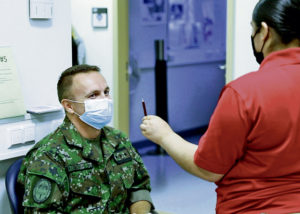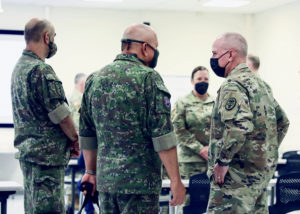
Medical professionals of the Slovak Republic Armed Forces visited with Landstuhl Regional Medical Center trauma specialists during a military medical expert exchange at LRMC, Aug. 19.
The exchange allowed the medical professionals to discuss best practices and increase interoperability between NATO allies.
The visit included discussions on LRMC’s unique Trauma program, which expands across three continents and encompasses four combatant commands, a tour of the hospital, a visit to LRMC’s European Medical Simulation Center and insight into LRMC’s Traumatic Brain Injury and Rehabilitation programs.
“We have senior leaders from the Slovak Armed Forces military medical service and (civilian health care specialists) who came to visit,” said U.S. Army Lt. Col. Brad Rittenhouse, medical director, Trauma Program, LRMC. “They want to find out what our (trauma care) practices are and also more complex surgical and inpatient care multidisciplinary practices.”
According to Rittenhouse, the amplified interoperability would benefit both NATO partners in efforts to enhance patient care for Service Members and families through the exchange of ideas.
“A lot of the processes and difficulties that we have are similar,” explains Rittenhouse. “If we understand each other’s practices then either on the battlefield or in peacetime we can better support the NATO alliance.”

The congregation included surgeons, physicians, nurses, medics and administrative personnel in efforts to capture LRMC’s exclusive trauma response program holistically. Also joining the group was the Slovak Armed Forces’ Deputy Surgeon General, Slovak Armed Forces Col. Jozef Ragan.
“The medical professionals (who visited) are leaders in their professions,” said Ragan. “We recognize the opportunity we have (through collaboration) to do our jobs better for our (Service Members).”
Although U.S. and Slovak Armed Forces have a history of cooperation on the battlefield through years of NATO operations in the Middle East, no formal program exists to exchange medical best practices.
“Through cooperation we can fill the (medical practice) gaps,” said Ragan. “I hope this visit will reveal those areas to allow us to eventually be able to work in combined teams.”
Although the informal visit was strictly an observation of how the DOD’s only Level II Trauma Center outside the U.S. operates, Ragan believes future training partnerships can evolve patient care for both nations.
“(Service Members) deserve the same treatment, whether you’re American or Slovak, and we should guarantee that treatment,” said Ragan.
According to Ragan, in addition to developing capabilities, the association may also contribute to advancing military medicine through research and education.
“It’s about creating capabilities which we can sustain and continue in tough times,” said Ragan. “You need a team which is properly trained and well communicated to support our troops during a war conflict or during disaster relief operations.”
Landstuhl Regional Medical Center is the only forward-stationed medical center for U.S. & Coalition forces, Department of State personnel, and repatriated U.S. citizens. The largest U.S. hospital outside the United States, LRMC serves as the sole military medical center for more than 205,000 beneficiaries throughout Europe, the Middle East and Africa. LRMC is also the evacuation and treatment center for all injured U.S. Servicemembers and civilians, as well as members of 56 Coalition Forces serving in Afghanistan, Iraq, as well as Africa Command, Central Command and European Command.


